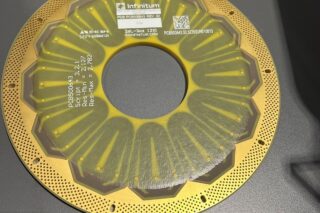In the face of increasing environmental challenges in urban areas—such as air pollution, urban flooding, and heat islands—Lafarge France has launched Hydromedia NewAir, a new draining and depolluting concrete designed to transform urban landscapes. This patented technology is designed to improve air quality, efficiently manage rainwater drainage, and combat urban heat islands.
Modern cities face significant environmental issues, including air pollution, urban flooding, and rising temperatures caused by heat islands. Hydromedia NewAir provides an innovative and effective solution to these challenges.
This innovative concrete is specifically engineered to allow rainwater to pass directly through its surface, reducing the risk of urban flooding and preventing excessive water runoff. By retaining moisture, it also helps cool surrounding areas, mitigating the effects of heat islands in urban environments.
A Concrete Revolution: How Does It Work?
Hydromedia NewAir operates through a dual mechanism of adsorption and mineralization of gaseous pollutants, particularly nitrogen oxides (NOx), which are predominantly emitted by vehicular traffic.
According to Mejda Bendani, Market Manager for Urban and Decorative Developments at Lafarge,
“Hydromedia NewAir works based on the adsorption and mineralization of gaseous pollutants like nitrogen oxides (NOx). The nitrogen dioxide (NO2) molecules are adsorbed and then mineralized into calcium nitrites and nitrates within the concrete’s porosity. This is made possible by its formula, which includes activated carbon and the concrete’s naturally basic environment.”
Its highly porous structure, with over 15% useful porosity, allows pollutants to be gradually washed away by rainwater. This slow leaching ensures that ion concentrations remain at least 10 times lower than the threshold for water pollution (50 mg/L).
Additionally, its open-pore design allows rainwater to permeate through the surface, significantly reducing urban flooding risks. It also helps combat heat islands by releasing retained moisture when exposed to high temperatures.
Environmental Impact
Hydromedia NewAir has the capacity to capture up to 200μg/m³ of NO2, effectively neutralizing high pollution peaks over 24-hour periods. To put this into perspective, an outdoor parking lot typically experiences NO2 pollution levels around 100μg/m³, but Hydromedia NewAir can instantly absorb 70μg/m³, significantly improving local air quality.
And as Bendani says, once captured, NO2 molecules are gradually converted into calcium salts that are then safely washed away by rainwater, ensuring a continuous self-cleaning process.
Water Permeability
One of the most impressive features of Hydromedia NewAir is its exceptional water permeability, Bendani explains:
“Its draining capacity is 50 liters per second per square meter, with a permeability rate of 3 mm per second.”
This makes it ideal for stormwater management in urban settings, reducing the risk of flooding and limiting soil impermeabilization.
Performance That Matches Traditional Concrete
Despite its advanced environmental capabilities, the company says Hydromedia NewAir retains the essential properties of traditional concrete:
“Hydromedia NewAir possesses the same characteristics as Hydromedia draining concrete, with a mechanical resistance of 15 MPa and a uniform porosity of over 15% throughout the entire surface and thickness. It has been technically approved by IDRRIM [the French Institute for Roads, Streets, and Infrastructure for Mobility].”
It also meets the NF EN 13201 photometric standard, ensuring compliance with industry regulations.
READ ALSO
Ideal for a Wide Range of Applications
While particularly beneficial in flood-prone areas, Hydromedia NewAir is also designed for a variety of urban infrastructure projects:
“It is compatible with pedestrian zones and light vehicle areas, with occasional heavy vehicle traffic. It is ideal for developments along high-pollution roadways, such as bike lanes and sidewalks. Additionally, it is perfectly suited for public spaces such as plazas, tramway tracks, and parking lots.”
Maintenance and Longevity
Like any draining concrete, Hydromedia NewAir requires preventative maintenance to prevent clogging:
“There are specific recommendations for preventing and treating clogging depending on the environment. In low-risk areas, a simple manual sweep once a year may suffice, while high-risk areas may require specialized cleaning machines like MobiClean. In dense tree-lined environments or areas with high pedestrian activity (e.g., chewing gum deposits), frequent leaf blowing and high-pressure washing are recommended.”
Cost and Sustainability Considerations
While pricing varies based on project specifics, Hydromedia NewAir remains a competitive choice for sustainable urban development, Bendani says:
“The cost starts at around 80 euros per square meter, including supply and installation (excluding ground preparation and special layouts). The final price depends on the project size, chosen finish, and specific groundwork requirements.”
Furthermore, it aligns with circular economy principles, as it can be manufactured using low-carbon cement and recycled aggregates, reducing CO2 emissions by up to 70% compared to conventional formulations.
For Bendani,
“Like all concrete, it can be recycled and repurposed for future use.”






![Image [Best of 2025] Power Moves in the Energy World](/wp-content/uploads/sites/3/energy-320x213.jpg)
![Image [Best of 2025] How Generative AI Is Transforming Industry](/wp-content/uploads/sites/3/AI-4-320x213.jpg)
![Image [BUYING GUIDE] How to Choose the Right Industrial Robot?](/wp-content/uploads/sites/3/Industrial-Robot-320x213.jpg)

![Image [Buying Guide] How to Choose the Right Safety Shoes?](/wp-content/uploads/sites/3/Safety-Shoes-320x213.jpg)